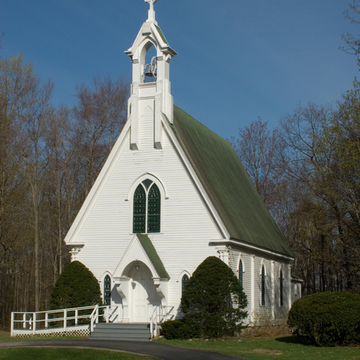This frame country church projects a high style that belies its modest size and industrial village setting. Forest Dale grew as a workers' community adjacent to an ironworks established by 1810 near ore fields in northeastern Brandon. Here Royal Blake built a stone furnace (now a State Historic Site), a company office, a store, workers' cottages, and his own impressive stone house. He also organized Brandon's St. Thomas parish in 1839, hosted services in his house, and financed the construction of Grace Church across the street. Architecturally conscious bishop John Henry Hopkins, a frequent visitor who likely provided input for the project, consecrated the building in 1853. Its design reflects the ideas of the New York Ecclesiological Society that from the late 1840s called for the construction of more authentic Gothic buildings and an end to Greek Revival buildings trimmed with Gothic details. American Ecclesiologists promulgated new church types influenced by the publications of A. W. N. Pugin and direct correspondence with their English counterparts, who sent drawings of suitable parish churches for emulation. One of these was the tiny thirteenth-century St. Michael's, Long Stanton, Cambridgeshire, with a simple open-timbered nave and gable-top bell cote, which was seen by Richard Upjohn and his colleagues as the ideal model for small rural parish churches. The church was published in A Book of Plans for Churches and Parsonages, compiled by the Central Committee of the General Congregational Convention in New York in 1853.
Grace Church is fully infused with the new aesthetic. The simple gabled mass has an exaggeratedly steep roof, echoed in the decorative bell cote and the bracket-supported door hood, which captures the proportions and spirit of Upjohn's St. Thomas, Amenia Union, New York, of 1851. Clustered Gothic colonnettes at the corners and lancet windows beneath head moldings complete the style. Despite its small size and original seasonal use (it was served by visiting clergy), Grace Episcopal embodied the latest ideas in church architecture at the time of its construction.





















